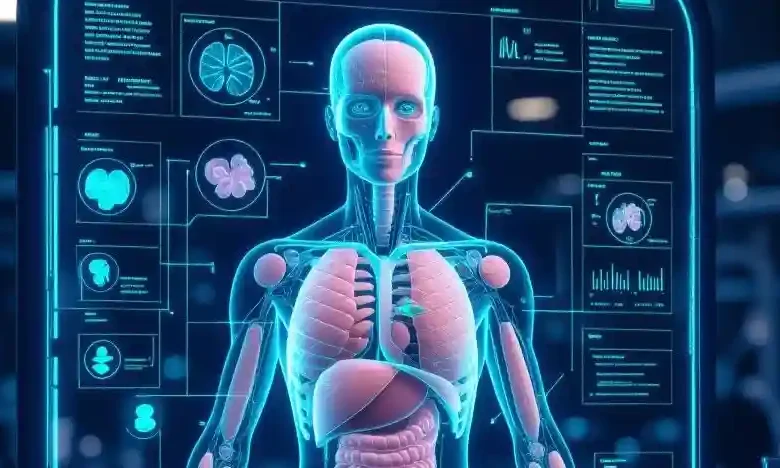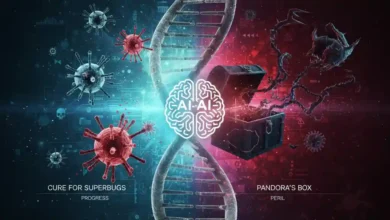Delphi-2M: The AI Oracle That Predicts 1,000 Diseases Years Before Diagnosis

Imagine a future where a doctor doesn’t just treat your illness but warns you years before it ever arrives. This isn’t science fiction anymore, it’s the frontier of medical AI, thanks to a groundbreaking model known as Delphi‑2M, which can forecast over 1,000 diseases long before symptoms appear.
This revolutionary model, trained on the medical histories of half a million people in the UK Biobank, is being heralded as a medical “oracle” and surprisingly, it’s built on the same underlying technology that powers conversational AI like ChatGPT.
But how does an AI leap from generating text to predicting heart attacks, cancer, or Alzheimer’s years before onset? And what does it mean for healthcare, privacy, and the very nature of being human? Let’s explore.
What Is Delphi-2M?
Delphi‑2M is an advanced predictive AI system designed to analyze massive amounts of longitudinal medical data, structured records of patients’ diagnoses, prescriptions, biomarkers, and lifestyle information over time. By spotting subtle correlations invisible to humans, it can generate probabilistic forecasts of disease risks years in advance.
- Training Data: 500,000 participant records from the UK Biobank, one of the world’s richest repositories of genetic, biological, and clinical data.
- Predictive Power: Over 1,000 disease outcomes including cancers, cardiovascular diseases, neurological disorders, and metabolic conditions.
- Technology Base: Transformer architecture, the same deep learning backbone that powers conversational AI models like GPT‑4.
Just as ChatGPT learns the “next word” from text sequences, Delphi‑2M learns the “next disease” in a human health trajectory.
Why This Is a Revolution
- Ultra‑Early Detection: Traditional health check‑ups often detect problems only when they have progressed. Delphi‑2M could alert doctors decades earlier, when simple lifestyle changes or preventive treatments are most effective.
- Precision Medicine at Scale: Instead of one‑size‑fits‑all guidelines, forecasts can be tailored to each patient’s unique medical history and genetics.
- Healthcare Cost Transformation: Preventing disease at early stages could save billions of dollars that are otherwise spent on late-stage interventions, hospitalizations, and long-term care.
- Data-Driven Public Health Policy: Beyond individual patients, an AI “disease forecasting map” could help governments allocate resources more efficiently, predicting regional spikes in diabetes or cardiovascular events years ahead.
How Does Delphi-2M Work?
At its core, Delphi‑2M is about sequence prediction. Just like ChatGPT predicts the next word in a sentence based on context, Delphi‑2M predicts the next possible diagnosis by reading the sequence of a patient’s medical history.
- Step 1 – Data Encoding: Electronic health records (EHRs) are converted into sequences of medical “tokens,” such as disease codes, lab values, or medication events.
- Step 2 – Pattern Recognition: The AI learns hidden statistical relationships between these events, not just simple cause and effect but intricate networks of risk factors.
- Step 3 – Probabilistic Forecasting: The model produces probabilities for over 1,000 possible future outcomes, highlighting the most likely future diagnoses.
This approach effectively lets the AI “read” a patient’s life like a narrative, spotting foreshadowing no human clinician has time or capacity to notice.
Potential Benefits
- Cancer Predicted Early: Subtle lab marker changes could indicate cancer years before tumors appear in scans.
- Cardiovascular Events Prevented: AI might flag high-risk profiles long before heart disease manifests, giving patients years to intervene.
- Alzheimer’s Forecasting: Subclinical health markers could allow proactive therapies decades before dementia symptoms.
- Rare Disease Identification: Conditions often missed for decades could be surfaced as early suspicions, saving lives through early specialist referral.
The Ethical and Privacy Dilemma
However, with power comes enormous responsibility and risk.
- Data Security: Sensitive medical information becomes the fuel for prediction. Who ensures this remains private in the age of AI?
- Psychological Burden: If you were told in your 20s that you had an 80% chance of developing Alzheimer’s by 60, would it improve or burden your life?
- Insurance & Employment Risks: Could predictive health profiles be misused by insurers, employers, or governments to discriminate?
- Algorithmic Bias: Trained primarily on UK population data, will predictions remain accurate across diverse global populations, or will marginalized groups be underrepresented and underserved?
Delphi‑2M forces society to weigh the promise of longer, healthier lives against the threats of misuse and inequity.
The Future of AI “Oracle Doctors”
The launch of Delphi‑2M signals a paradigm shift in medicine, from reactive to predictive and preventive. A future clinic visit may not start with “What are your symptoms?” but with “Here’s what will likely happen in 10 years, let’s change it.”
In the next decade, we may see:
- Consumer health apps powered by predictive AI, scanning your health trajectory just like fitness trackers today.
- Integration with genomics and wearable biosensors, creating real-time health forecasting systems.
- A new medical profession of “health forecasters” trained to interpret AI predictions with empathy.
- Bioethics frameworks to guide how much foreknowledge individuals and societies should wield.
Why Delphi-2M Matters Beyond Medicine
Delphi-2M embodies a larger story: the convergence of AI language models with human life prediction models. If an algorithm can learn the “grammar of disease,” what other hidden grammars of reality might AI uncover? From predicting climate shifts to anticipating economic collapses, we are entering an era of forecasting intelligence.
Medicine is only the first domain where the ability to read the future moves from myth into science.
The Sciencealert article related to this topic. Click here.
Follow Odinozz on social media. Click here.



